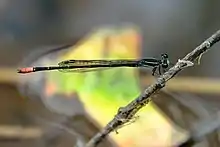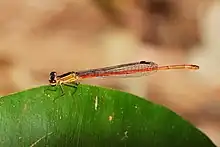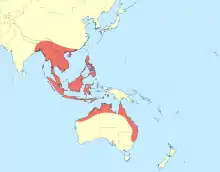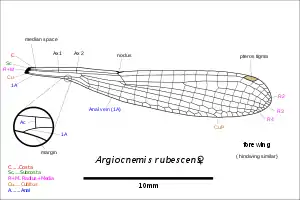| Argiocnemis rubescens | |
|---|---|
 | |
| Male, Queensland | |
 | |
| Female | |
| Scientific classification | |
| Domain: | Eukaryota |
| Kingdom: | Animalia |
| Phylum: | Arthropoda |
| Class: | Insecta |
| Order: | Odonata |
| Suborder: | Zygoptera |
| Family: | Coenagrionidae |
| Genus: | Argiocnemis |
| Species: | A. rubescens |
| Binomial name | |
| Argiocnemis rubescens | |
 | |
Argiocnemis rubescens is a species of damselfly in the family Coenagrionidae,[2] commonly known as the red-tipped shadefly.[3] It is a widespread species extending from India to southern China, south-east Asia, New Guinea and Australia.[3]
It prefers fresh still waters such as pools, marshes and swamps. The adult is a small to medium-sized damselfly with a length of 35 to 40mm, and the hindwing less than 22mm. When immature it is a pale reddish brown. The mature male is dark with pale green stripes on the thorax, and red on segments 8 and 9. In Australia, the distribution is in suitable habitat from Shark Bay in the west, across the north of the continent, to about Point Hicks in the south-east.[3] The taxon has been assessed in the IUCN Red List as least concern.
Etymology
The species name rubescens is a Latin word meaning reddish. Edmond de Sélys Longchamps named this species of damselfly after the colour of the upper surface of its abdomen.[1][4]
Gallery
 Illustration of wing with inset depicting the anal vein (1A) leaving the margin on the basal side of the anal crossing vein (Ac). This is a characteristic of the genus.
Illustration of wing with inset depicting the anal vein (1A) leaving the margin on the basal side of the anal crossing vein (Ac). This is a characteristic of the genus..jpg.webp) Photo of female wings
Photo of female wings.jpg.webp) Photo of male wings
Photo of male wings
References
- 1 2 Selys-Longchamps, E. (1877). "Synopsis des Agrionines, 5me légion: Agrion (suite et fin). Les genres Telebasis, Argiocnemis et Hemiphlebia". Bulletin de la Classe des Science, Académie Royale de Belgique. 2 (in French). 43: 97–159 [136] – via Biodiversity Heritage Library.
- ↑ "Species Argiocnemis rubescens Selys, 1877". Australian Faunal Directory. Australian Biological Resources Study. 2012. Retrieved 6 April 2017.
- 1 2 3 Theischinger, G; Hawking, J (2006). The Complete Field Guide to Dragonflies of Australia. Collingwood Vic.: CSIRO Publishing. p. 98. ISBN 978 0 64309 073 6.
- ↑ Endersby, Ian; Fliedner, Heinrich (2015). The Naming of Australia's Dragonflies. Eltham, Victoria, Australia: Busybird Publishing. ISBN 9781925260625.
